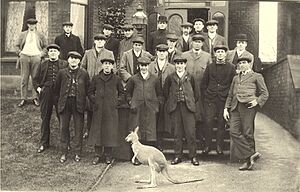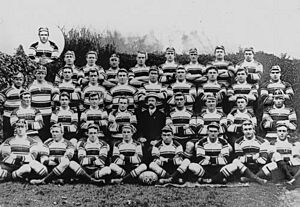Sandy Pearce facts for kids
- Sid Pearce directs here, for his son, the rugby league footballer of the same name, see Joe Pearce

Pearce in 1910
|
||||||||||||||||||||||||||||||||||||||||||||||||||
|
Personal information
|
||||||||||||||||||||||||||||||||||||||||||||||||||
|---|---|---|---|---|---|---|---|---|---|---|---|---|---|---|---|---|---|---|---|---|---|---|---|---|---|---|---|---|---|---|---|---|---|---|---|---|---|---|---|---|---|---|---|---|---|---|---|---|---|---|
| Full name | Sidney Charles Pearce | |||||||||||||||||||||||||||||||||||||||||||||||||
| Born | 30 May 1883 Double Bay, Australia |
|||||||||||||||||||||||||||||||||||||||||||||||||
| Died | 14 November 1930 (aged 47) Double Bay, Australia |
|||||||||||||||||||||||||||||||||||||||||||||||||
|
Playing information
|
||||||||||||||||||||||||||||||||||||||||||||||||||
| Height | 178 cm (5 ft 10 in) | |||||||||||||||||||||||||||||||||||||||||||||||||
| Weight | 87 kg (13 st 10 lb) | |||||||||||||||||||||||||||||||||||||||||||||||||
| Position | Hooker | |||||||||||||||||||||||||||||||||||||||||||||||||
|
||||||||||||||||||||||||||||||||||||||||||||||||||
|
Source: Yesterday's Hero
As of 1 August 2009
|
||||||||||||||||||||||||||||||||||||||||||||||||||
Sidney Charles Pearce (born May 30, 1883 – died November 14, 1930), known as Sandy, was an Australian rugby league player and boxer. He was a true pioneer in the sport of rugby league. Many people consider him one of Australia's best footballers of the 20th century.
In 1907, Sandy played for New South Wales. This was in the first rugby match run by the new 'New South Wales Rugby Football League'. This league had just separated from the older New South Wales Rugby Football Union. He first played for the national team in 1908.
Contents
Club Career
Sandy Pearce played as a hooker. He spent his entire career playing for the Eastern Suburbs club. He played 157 matches between 1908 and 1921.
Pearce was a key player when Eastern Suburbs won three championships in a row. This happened from 1911 to 1913. He also helped his team win the City Cup three times. These wins were from 1914 to 1916.
He was the first Eastern Suburbs player to reach 100 matches for the club. He was also the first player in the New South Wales Rugby Football League premiership to play in 150 matches.
Playing for Australia
Sandy Pearce was part of the team that played against the New Zealand 'All Golds' in 1908. This helped to start rugby league in Australia.
He went on the very first Kangaroo tour to England in 1908–09. On this tour, he was one of only five players to play in all three Test matches. He also played in 30 other games during that tour. He also represented the Australasia team.
Pearce and his friend Dally Messenger decided not to go on the 1911–12 Kangaroo tour of Great Britain.
When he was 38 years old, he was chosen again for the 1921–22 Kangaroo tour of Great Britain. He played in two Test matches and nineteen other games on this tour.
In total, he played in 14 of the first 17 Test matches between Australia and England. His last Test match was on November 5, 1921. At 38 years and 158 days old, he became the oldest player to represent Australia. When he retired, he had played more Test matches for Australia than anyone else.
Sandy Pearce and his son Joe Pearce made history. They were the first father and son to both play for Australia in rugby league.
Sandy Pearce is listed as Kangaroo No. 17 on the Australian Players Register.
A Family of Sporting Stars
Sandy Pearce came from a family of amazing athletes.
- His father, Harry Pearce, was a world champion sculler (rower).
- Sandy's brother, Walter, was a fantastic long-distance cyclist.
- His sister, Lilly Pearce, was also a skilled sculler. She was the first woman to ride an aquaplane on Sydney harbour.
- His nephew, Bobby Pearce, was a very famous rower. He won two Olympic gold medals in sculling.
- Sandy's own son, Joe Pearce, followed him into rugby league. Joe played for Eastern Suburbs and represented NSW and Australia.
Awards and Recognition
In 1914, Sandy Pearce was given a Life Membership of the New South Wales Rugby League. After he stopped playing, Pearce became a trainer for the University rugby league club.
Later Life and Legacy
Sandy Pearce had a long career without many injuries. He passed away at 47 years old from heart strain. His funeral procession was very long, showing how much he was respected. Famous rugby league players like Dally Messenger and Frank Burge were pallbearers. He was buried at South Head Cemetery on November 15, 1930.
His former teammate, Frank Burge, spoke about Sandy in 1940. He said Sandy was an incredibly tough and loyal player. Burge believed Sandy was the best hooker he had ever seen. He mentioned Sandy's great strength and how he trained.
Sandy Pearce was called 'The Prince Of Hookers'. He is included in the Eastern Suburbs 'Team of the Century'. He was also named in Easts' 'Centurion' team, for players who played over 100 matches. In 2005, he was added to the Australian Rugby League Hall of Fame.
In February 2008, Pearce was named in the list of Australia's 100 Greatest Players. This list was made to celebrate 100 years of rugby league in Australia. In 2008, New South Wales also named Pearce as the hooker in their team of the century.



